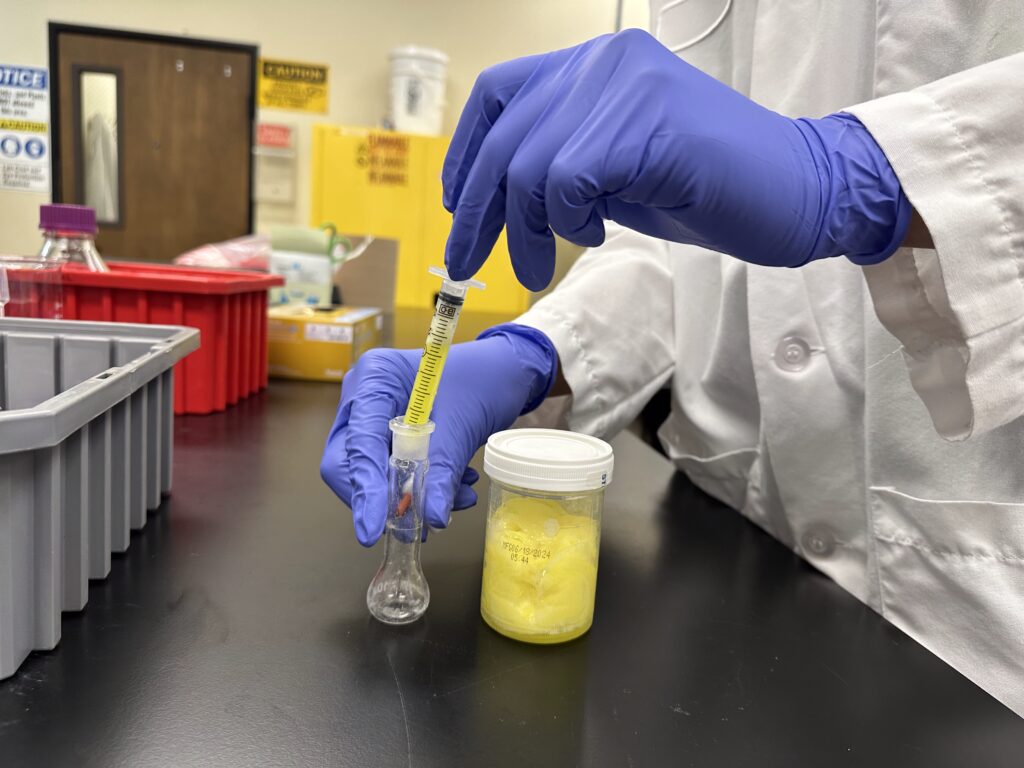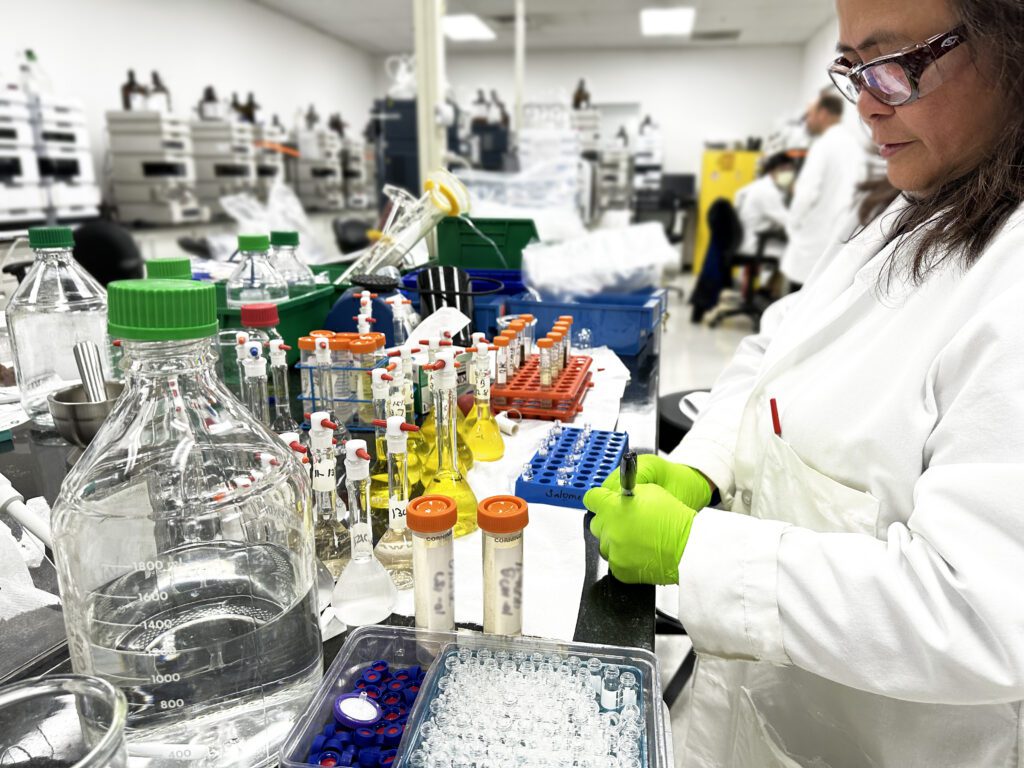Reviewed and Approved by Matt Traynor, PhD, Innovation and Validation Director, Certified Laboratories
1-Minute Summary
- Method validation ensures testing methods are accurate, consistent, and reliable across different conditions, products, and analysts.
- The ICH Q2(R2) guidelines define key criteria – specificity, linearity, detection limits, accuracy, precision, and robustness – to validate analytical methods effectively.
- Validated methods are critical for regulatory compliance, consumer safety, and maintaining product quality in regulated industries like OTC drugs, cosmetics, supplements, and food products.
- Certified Laboratories provides expert testing using validated methods and can help develop custom validation protocols for your specific product needs.
Validating a Method is Like Testing a Recipe
Imagine you’re baking a cake using a tried-and-true family recipe that never seems to let you down. While you think the recipe is foolproof, there are questions:
- Will it work every time?
- What if you bake it in a different oven?
- What if someone else uses the recipe?
- Will it turn out the same?
Analytical method validation is like testing that recipe, ensuring your “recipe” for testing products works consistently, no matter who’s performing the test or the conditions.
With regulated products like OTC drugs, cosmetics, supplements, or food, the stakes are much higher than a tasty piece of cake. You need reliable test methods to ensure your products are safe, effective, and meet regulatory requirements.
So, how is an analytical test method validated? Let’s find out.

What is Analytical Method Validation?
Analytical method validation is the process of proving that a testing method (your recipe, to continue the analogy) is accurate, consistent, and reliable under various conditions. Think of it as ensuring the method works for every batch, formulation, and analyst.
Here’s an example to illustrate.
Say you’re an OTC drug manufacturer that is testing an acne cream to ensure it contains exactly 2% salicylic acid, as labeled. Validation confirms that your test method…
- Accurately measures salicylic acid without interference from other ingredients.
- Delivers consistent results even when run by different analysts or on different days.
- Works for different product batches.
These principles are codified in the ICH harmonised guideline document “Validation of Analytical Procedures Q2(R2)”, the global standard for method validation.
The Seven ICH Criteria for Method Validation
According to the ICH Q2(R2) guidelines, there are seven key criteria to validate an analytical method. Think of these as the checks and balances that ensure your “testing recipe” works every time. Here they are; we’ll explain each one below.
- Specificity/Selectivity
- Linearity
- Limit of Detection (LOD)
- Limit of Quantification (LOQ)
- Accuracy
- Precision
- Robustness
These criteria collectively ensure that your testing method is like a foolproof recipe – one that works in any kitchen, with any chef, and under any reasonable condition.
Why Is Analytical Method Validation So Important?
Imagine you’re serving your cake at a big event. You can’t risk failure because you doubled the ingredients or used a different brand of flour.
In the same way, unvalidated methods can lead to inaccurate results, regulatory scrutiny, or even product recalls.
Here’s why method validation is essential:
Regulatory Compliance
Using validated methods is the gold standard across industries, and regulatory frameworks make this clear. For instance, 21 CFR 211 outlines the requirements for testing OTC drug products, emphasizing the need for scientifically sound, fit-for-purpose methods. Validated methods ensure reliable results that hold up during inspections and audits.
Recently, we’ve observed the FDA placing increased focus on method validation during audits, particularly for OTC drug testing. Incorporating validated methods into your testing protocols is not just a regulatory expectation, it’s a cornerstone of a robust safety and quality program for your company.
Consumer Safety
Accurate testing ensures that products meet safety standards. For instance, if you’re testing a vitamin supplement, validation confirms the results so consumers get the promised nutrients – not too much or too little.
Quality Assurance
Validation protects your reputation. Consistent, reliable results show that your products meet the high standards your customers expect.

How Do You Validate an Analytical Method?
Validation involves testing your method under various conditions to ensure it works reliably. Let’s break it down step by step.
Step 1: Define the Purpose
Validation requires defining the scope and purpose of the method.
- What is the method measuring? (e.g., the concentration of salicylic acid in a cream.)
- What is the intended use? (e.g., batch release, stability testing, raw material qualification.)
- What are the critical parameters? (e.g., detection limits, linear range.)
Step 2: Assess Feasibility
Think of this as a trial run. Feasibility testing determines whether the method can work with the specific product or matrix you’re testing.
- If you’re measuring salicylic acid in a cream, test the method using a few initial samples to identify potential interference from ingredients like oils or emulsifiers.
- Evaluate whether adjustments are needed to improve sensitivity, precision, or robustness.
Step 3: Develop a Validation Plan
A robust validation plan outlines how you will validate the method and includes…
- Validation criteria: The seven ICH criteria, which we explain in Step 4 below.
- Experimental design: Define how each criterion will be tested. For instance, how many concentrations will you test for linearity? How many replicate tests will you run for precision?
- Acceptance criteria: Set pass/fail thresholds. For example, linearity might require a correlation coefficient (R²) of at least 0.99.
Step 4: Conduct Full Validation
Full validation is the heart of analytical method validation, where the method is rigorously tested against the seven ICH Q2(R2) criteria. These criteria ensure the method is accurate, reliable, and fit for its intended purpose. Here’s how each criterion is addressed during validation:
Specificity/Selectivity
- The method must detect only the target analyte without interference from other substances in the product matrix.
- Example: Test a cream with known concentrations of salicylic acid to ensure no signals from excipients like oils or preservatives interfere.
Linearity
- Demonstrate that the method’s response is directly proportional to the analyte concentration over the working range.
- Example: We prepare known standards of salicylic acid at five concentrations and ensure the test results increase in a linear manner with the concentration of salicylic acid.
Limit of Detection (LOD)
- The LOD is the smallest amount of the analyte (e.g., salicylic acid) that the method can detect, but not necessarily measure accurately.
- Example: Use very low concentrations of salicylic acid and confirm the method can consistently identify its presence, even at these minimal levels.
Limit of Quantification (LOQ)
- The LOQ is the smallest amount of the analyte that can be both detected and measured accurately and precisely.
- Example: Test low concentrations of salicylic acid and confirm the method provides reliable, repeatable numbers for how much is present.
Accuracy
- Validate that the method measures the true concentration of the analyte.
- Example: Spike samples with known concentrations of salicylic acid and compare measured results to expected values. Accuracy is expressed as the percentage recovery of the spiked amount.
Precision
- Ensure the method produces consistent results under repeatable and variable conditions.
- Repeatability: Analyze the same sample multiple times under identical conditions.
- Intermediate Precision: Test the method across different analysts, instruments, and days to confirm robustness.
Robustness
- Prove that small, deliberate variations in testing conditions do not affect the method’s reliability.
- Example: Slightly adjust parameters such as flow rate, temperature, or pH and confirm the method remains accurate.
- Solution stability can also be included here. Confirm that prepared solutions remain stable over time and under storage conditions.
- Example: Prepare a salicylic acid solution, analyze it immediately, and then re-analyze it after 24 or 48 hours to ensure consistent results.
Step 5: Perform Verification for New Applications
Once a method is validated, it can often be used for similar products, but not without verification. Verification confirms that the validated method works on a new formulation or matrix.
For example, if your validated method for salicylic acid works for creams, you would verify it for use with a gel. This might involve running a subset of the validation tests (e.g., specificity and accuracy) to ensure the method remains reliable.
Minor formulation changes such as fragrance or color do not always require full re-verification, but if you are unsure always consult with your QA team or our validation experts at Certified Laboratories
Step 6: Document the Validation Process
Validation is incomplete without thorough documentation. Regulators require detailed records that include:
- The validation protocol (plan) and experimental design.
- Raw data and analysis for each criterion.
- A final report summarizing the results and confirming whether the method meets the validation requirements.
Think of this as your method’s portfolio. It proves to regulators (and your team) that the method is reliable and suitable for its intended purpose.
Contact us for Validated Analytical Methods to Test Your Products
Validated analytical methods are essential for accurate testing and regulatory compliance, ensuring product safety and reliability. Certified Laboratories offers expert testing using validated methods and can help develop custom methods tailored to your needs. Contact us today to ensure your products meet the highest standards.
